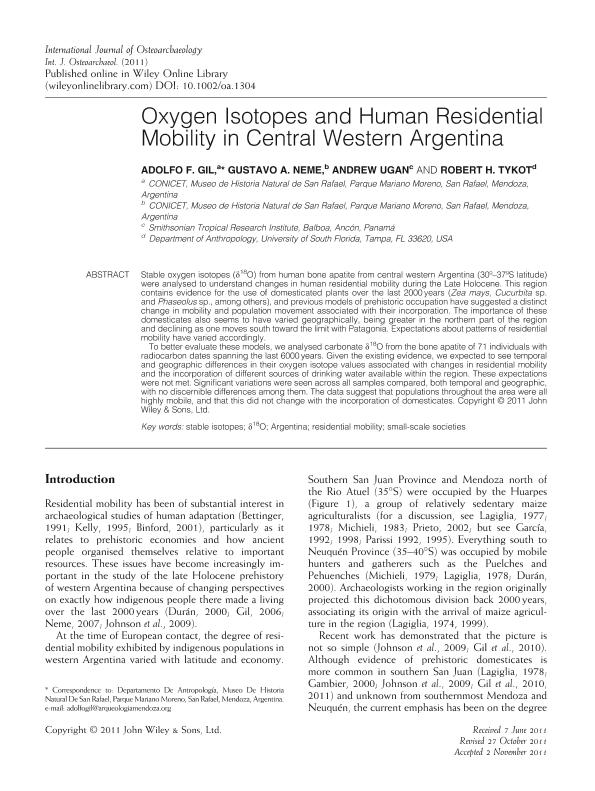Mostrar el registro sencillo del ítem
dc.contributor.author
Gil, Adolfo Fabian

dc.contributor.author
Neme, Gustavo Adolfo

dc.contributor.author
Ugan, Andrew
dc.contributor.author
Tykot, Robert H.
dc.date.available
2017-10-02T17:47:43Z
dc.date.issued
2014-02
dc.identifier.citation
Gil, Adolfo Fabian; Neme, Gustavo Adolfo; Ugan, Andrew; Tykot, Robert H.; Oxygen isotopes and human residential mobility in central western Argentina; Wiley; International Journal of Osteoarchaeology; 24; 1; 2-2014; 31-41
dc.identifier.issn
1099-1212
dc.identifier.uri
http://hdl.handle.net/11336/25587
dc.description.abstract
Stable oxygen isotopes (d18O) from human bone apatite from central western Argentina (30º–37ºS latitude) were analysed to understand changes in human residential mobility during the Late Holocene. This region contains evidence for the use of domesticated plants over the last 2000 years (Zea mays, Cucurbita sp. and Phaseolus sp., among others), and previous models of prehistoric occupation have suggested a distinct change in mobility and population movement associated with their incorporation. The importance of these domesticates also seems to have varied geographically, being greater in the northern part of the region and declining as one moves south toward the limit with Patagonia. Expectations about patterns of residential mobility have varied accordingly. To better evaluate these models, we analysed carbonate d18O from the bone apatite of 71 individuals with radiocarbon dates spanning the last 6000 years. Given the existing evidence, we expected to see temporal and geographic differences in their oxygen isotope values associated with changes in residential mobility and the incorporation of different sources of drinking water available within the region. These expectations were not met. Significant variations were seen across all samples compared, both temporal and geographic, with no discernible differences among them. The data suggest that populations throughout the area were all highly mobile, and that this did not change with the incorporation of domesticates.
dc.format
application/pdf
dc.language.iso
eng
dc.publisher
Wiley

dc.rights
info:eu-repo/semantics/openAccess
dc.rights.uri
https://creativecommons.org/licenses/by-nc-sa/2.5/ar/
dc.subject
Stable Isotopes
dc.subject
D18o
dc.subject
Argentina
dc.subject
Residential Mobility
dc.subject.classification
Arqueología

dc.subject.classification
Historia y Arqueología

dc.subject.classification
HUMANIDADES

dc.title
Oxygen isotopes and human residential mobility in central western Argentina
dc.type
info:eu-repo/semantics/article
dc.type
info:ar-repo/semantics/artículo
dc.type
info:eu-repo/semantics/publishedVersion
dc.date.updated
2017-09-26T18:58:50Z
dc.journal.volume
24
dc.journal.number
1
dc.journal.pagination
31-41
dc.journal.pais
Reino Unido

dc.journal.ciudad
Chichester
dc.description.fil
Fil: Gil, Adolfo Fabian. Museo Municipal de Historia Natural San Rafael - Unidad Asociada al CCT Mendoza; Argentina. Consejo Nacional de Investigaciones Científicas y Técnicas; Argentina
dc.description.fil
Fil: Neme, Gustavo Adolfo. Museo Municipal de Historia Natural San Rafael - Unidad Asociada al CCT Mendoza; Argentina. Consejo Nacional de Investigaciones Científicas y Técnicas; Argentina
dc.description.fil
Fil: Ugan, Andrew. Smithsonian Tropical Research Institute; Panamá
dc.description.fil
Fil: Tykot, Robert H.. University of South Florida. Department of Anthropology; Estados Unidos
dc.journal.title
International Journal of Osteoarchaeology
dc.relation.alternativeid
info:eu-repo/semantics/altIdentifier/url/http://onlinelibrary.wiley.com/doi/10.1002/oa.1304/abstract
dc.relation.alternativeid
info:eu-repo/semantics/altIdentifier/doi/http://dx.doi.org/10.1002/oa.1304
Archivos asociados
